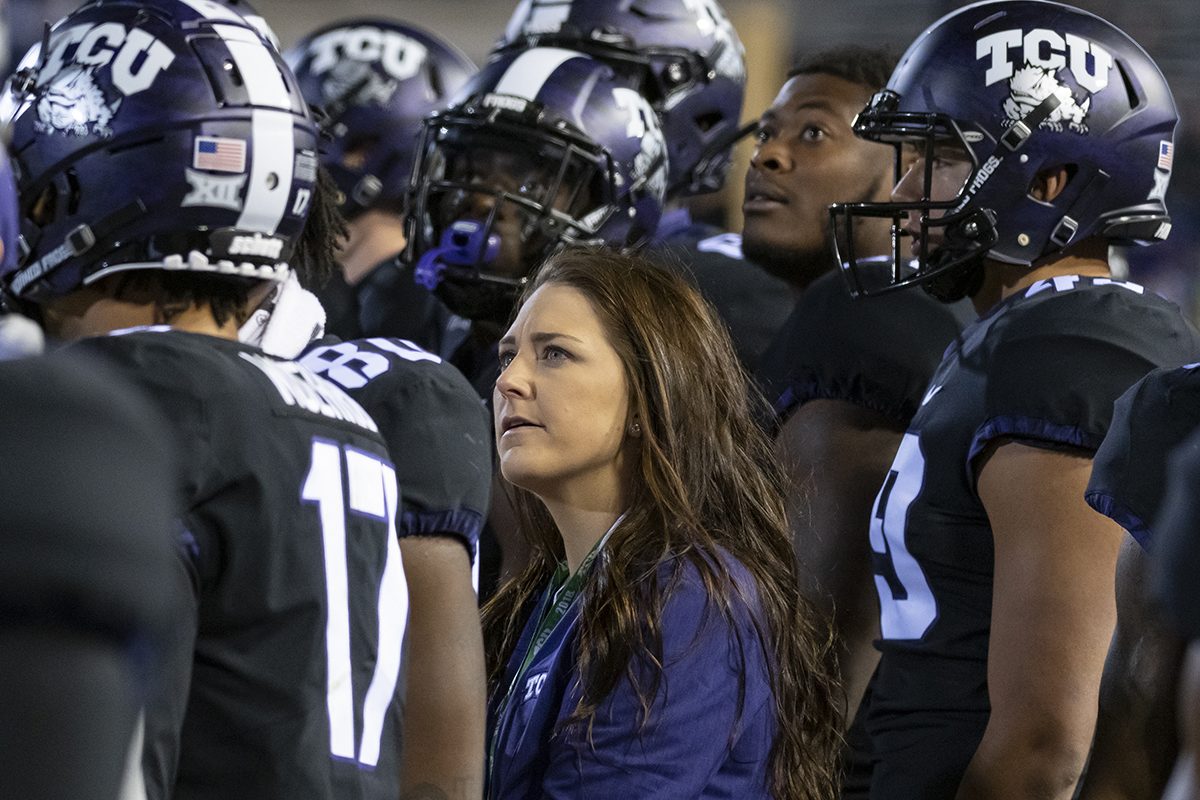
Brooke Helms, director of sports nutrition, is on the sidelines of every TCU football game including this matchup against Oklahoma State in November 2018. Photo by Glen E. Ellman
Brooke Helms Manages Nutrition Needs of Athletes
The director of sports nutrition designs meal plans and provides one-on-one counseling sessions with student-athletes.
The registered dietitian advises TCU athletes on which foods are best for their performance goals. As a certified specialist in sports dietetics, Helms combines her experience as an athlete with nutrition.
What is one thing that you’ve had to gain insight about with student-athletes?
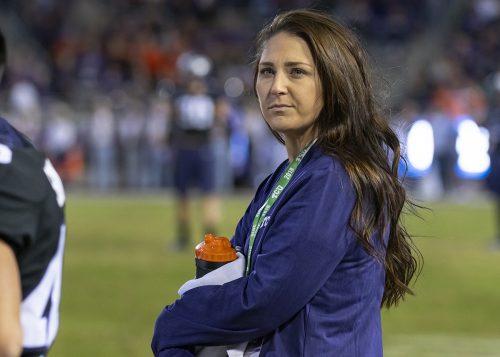
Brooke Helms, registered dietitian, is in charge of athletes eating properly and also has the task of keeping the football team’s energy levels up and hydrated. She also roams the sidelines with a special mix for players who need extra hydration. Photo by Glen E. Ellman
So many athletes at this level come in and don’t eat fruits or vegetables, have never tried certain vegetables, refuse to eat a vegetable. I call them the “fast-food generation” babies — that’s all they’ve ever eaten at home. It could be economic. It could be family lifestyle. It could be a lot of factors.
But I’m not seeing a lot of athletes who had home-cooked meals with their families. Instead, it’s Cane’s or Whataburger or pizza or wings. And that is it every night, or a burger is their only source of protein, but there’s always french fries, and there’s always a soda.
One of the good things is that they’re always hungry. That means I have an opportunity to teach and educate because a lot of them depend on us as their only source of food. The good thing is they’re athletes, and they want to be better: that mindset of wanting to do well and wanting to perform and having a reason to change a bad habit.
Do you get pushback from student-athletes?
A lot of times, nutrition isn’t the main focus in high school sports, but training and maybe weightlifting. I will always have some athletes who come in and say, “I’ve never eaten breakfast before and that got me here, so why should I eat breakfast?” My response is, “You may have been the best where you were, but here everyone is also the best. You’re now competing against your teammates for a starting position. What can you do to make yourself better or to improve your performance? If nutrition can be that tool, why would you not do that?” Performance focus is the main thing I do.
I’m never going to get an athlete to eat peppers just for the sake of their cholesterol or for vitamin C. But telling them this may help prevent them from getting sick, so they can play a whole season — that’s how I have to connect with them. It’s a giant game of translation and finding relevance with them in terms of performance and how they perform.
What is the importance of a nutritionist in athletics?
The visibility and the rapport that I have to have with someone in order to change behavior is key in my profession. I could easily give everyone the same paper and the same handout and maybe only two people do it — versus half of the team doing it because I’m here with them, making sure I see them in the training table. I see them in the fueling station. I’m available for them to come in and chat with even if it’s one question. They have my cellphone number. I travel with them, or I set them up for travel. I check on them when they’re on away trips.
I’m here full-time. And I’m here when they’re here. Essentially, anytime they’re here or anytime they’re eating, I’m here. And so when they see me and can associate me with the food, and maybe what we’ve talked about, then it starts to click for them.
I’m a firm believer that I have to be visible and I have to be present. I have to build rapport in order to see any changes or to elicit that behavioral change. Trust is key, and if you’re putting in the time like they’re putting in the time and truly invested in them, that’s where I get the biggest response from athletes.
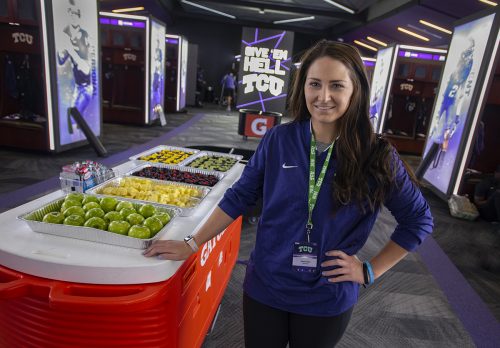
Helms said building trust is key for communicating with student-athletes. Being visible is another way the dietitian builds rapport. Photo by Glen E. Ellman
Sometimes I’m the bad guy. I don’t have a problem with that. I don’t force them to do anything, but I encourage them to do something. If I’m not visible, I don’t know what each athlete is willing to do or what that athlete is capable of doing. I have to approach each athlete individually from that standpoint and how much I can influence them. That’s why I love it.
Every athlete is different. I get to try different strategies and different techniques. For one athlete, I may be just talking about what is the best worst thing on the McDonald’s menu. Or another athlete who I’m talking to about a vegan diet. Or an athlete with ulcerative colitis, and we’re trying to figure out what they can eat when they go to Puerto Rico. I could be talking to all of those athletes in one day. I love that it’s never the same.
Tell me about your 80/20 rule.
It’s my go-to: 80 percent of the time, eat clean — not necessarily healthy because healthy is subjective. If 80 percent of the time we can keep it clean, then 20 percent of the time we can have a little more freedom with what we do — but not overboard. It’s a balanced way of thinking. No one can be perfect all the time. I think we will get burnt out. It puts into perspective their whole week’s eating routine and not just that day. If yesterday was bad, then today needs to be a little better. Resetting each day doesn’t take into account that yesterday was bad. If they continue the cycle of bad, reset, bad, reset, there’s no balance there. That’s when it sets us back in terms of goals, because our nutrition is cumulative.
It takes away some guilt my athletes can feel: thinking they failed, or didn’t do what I asked, or one day was bad so they might as well forget all week. That’s not the way to think about it. That relationship with food and their mindset related to their goals can be distorted sometimes. That’s what we work on in my one-on-one counseling sessions.
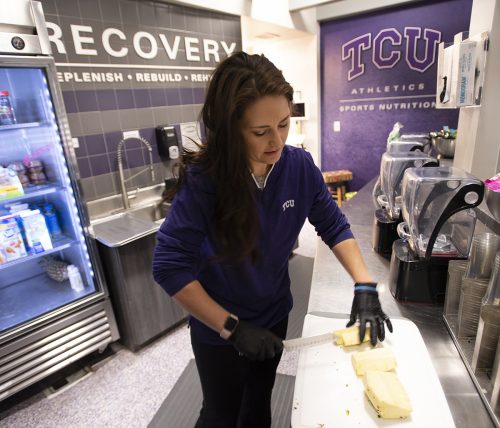
Helms works for several hours prior to the start time on game day to prepare snacks and hydration options for the players. Photo by Glen E. Ellman
What’s in your 20 percent?
I love salty and crunchy things. My weaknesses are probably salt and vinegar chips.
What are some of your strategies when consulting with athletes?
I have to take my own personal biases out of things when I talk to athletes and can’t assume they like foods that I like. Same thing with menu writing. It’s helping them understand that french fries don’t count as their vegetable and the bun on their burger and the soda are both carbs. I break it down to them and say, “If I told you that you need a carb, a protein and a healthy fat, but your meal is three carbs and one protein, we’ve got to take something away.” I let them pick. I don’t do it for them because if they pick they’re more likely to stick with it than if I tell them what to do — unless they tell me they need to be told what to do. I usually give them two options that I selected, but they pick. That seems to work well as opposed to just me writing a meal plan. I always talk about how to make things cleaner.
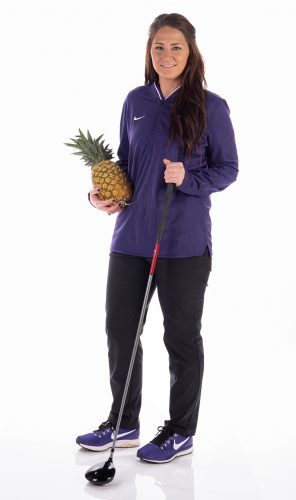
Helms was a golfer at Seminole State College in Oklahoma and understands the perspective of a student-athlete. Photo by Glen E. Ellman
A lot of times an athlete’s goal isn’t to eat healthier but they want to have more energy or gain and maintain weight. Probably 75 percent of athletes that I see need to gain or maintain weight.
People think of a dietitian as someone who helps with weight loss, but that’s not the key at all. I know it’s kind of unfathomable to the normal person, but it’s difficult for them to gain weight or they can’t gain weight with as much as they’re practicing, as much as they’re working out, as much as they’re running around busy with their day and forget to eat. They would rather sleep or study. I compete with those as well. I tell them it shouldn’t be a competition, so a lot of what I do is helping them plan their days — helping them plan their schedules and plan food around that schedule.
What’s your go-to healthy meal recommendation?
For athletes, a super easy meal can start with a rotisserie chicken which is already made at the grocery store and should last them about three to four meals, depending on body size. There are also 90-second rice packets that can be easily microwaved. They don’t even have to get out a pan. Then a pack of frozen vegetables that costs $1 — they can easily put in some water and steam that. They can have a protein, a starch and a vegetable in a matter of less than five minutes. It’s that easy. It may be $2 for a meal.
If time and money are major obstacles for healthy eating, how do you keep athletes away from fast food?
I have to be very creative. I can’t just say, “Don’t do that.” I have to have a solution. I ask them, “What drew you to this meal? Is it the taste of the food? Is it the cost? Is it how quick/convenient it was?” I break it down because if not, I’ll just go tit for tat with them and say it’s cheaper to actually go buy groceries. And they will say it’s not because they can get five double cheeseburgers for $5.
I make a meal — that way there’s no excuse. It’s cheap, it’s convenient, they don’t have to cook it. Now they’ve got a cleaner meal. I probably saved them money and time. Instead of four trips to get fast food, it’s one trip to the grocery store. I get to be creative with that and kind of come up with a plan that matches what their issue was with getting a healthier meal.
Give me four tips that a person can use to stay on track during a holiday season.
Eat breakfast. Whatever your meal is, make sure you eat clean either before or after. People who skip a meal because they plan to eat so much at lunch or dinner are more prone to overeat. Their blood sugar and energy level gets so low that when the meal comes, they overeat.
Make it balanced. If you’re going to go all out on Thanksgiving lunch — which I don’t deter people enjoy the holidays; just don’t overindulge — make it balance. If you do go a little overboard, make up for it either before, after or the next day. Get back on track. That’s the key. Don’t get off track. Maintain your normal diet; make it a little cleaner as possible.
Exercise. Take a walk the day of your meal or something like that. But our athletes, I say stay on track. Make sure you get a workout in on that day. Somehow, no matter what it is, make sure you stick with your routine.
Be aware of portion control. Fill your plate with a backwards method. If you have an issue with carbs or desserts, start with vegetables: Fill your plate with a salad first. Next add your lean proteins, and then do your starches last. If you build your plate that way, then you only have a certain amount of room left for starches. Then eat the meal in the order that you placed it on your plate. If you think you want seconds, wait 15 minutes after you finish your plate. It’s a method of slowing yourself down and giving your stomach time to communicate with your brain.
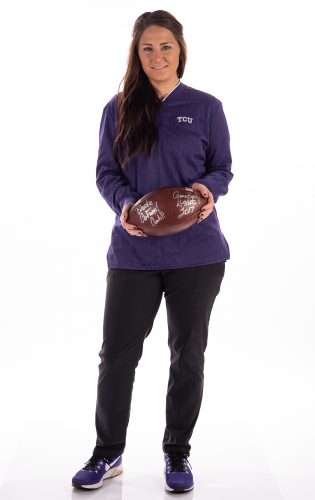
Helms holds the game ball from the October 2017 matchup against Kansas State that was riddled with weather delays. Head Coach Gary Patterson awarded her the ball for her efforts to keep the team sustained. Photo by Glen E. Ellman
An October 2017 football game against Kansas State in Manhattan, Kansas, had a total of four hours in rain delays. The first delay lasted three hours. How did you keep the team game-ready?
I only had one round of rain-delay snacks that we blew through when the first delay was announced. I jumped in the semi with our semitruck driver, his wife and director of operations. We went to the nearest grocery store not knowing how long the rain delay would last. The team could have gotten back on the field within 30 minutes; it could have been four hours. Like the show Supermarket Sweep, I was going down aisles with a shopping cart just grabbing items. We had the store manager helping us. They closed off a checkout line for us.
Then we called the field to get everybody ready. We had medical gloves. We had the equipment staff, the athletic training students, myself and some of the other staff members. We put sanitary coverings on the taping tables, and I established a sandwich assembly line. We whipped out 200 sandwiches in an hour.
The game had a 10:30 a.m. kickoff, which was already over lunch, with a four-hour rain delay. Then the game lasts four hours, so that’s eight hours without fuel — for the players and coaches. We won and Coach P gave me the game ball.
Editor’s Note: The questions and answers have been edited for length and clarity.

Your comments are welcome
5 Comments
Great article about an awesome young professional! Way to go Brooke. TCU is lucky to have you.
Proud of you, Brooke! Great accomplishments for a great person! Keep it up!
Loved reading about our home town girl from Eufaula, Brooke Helms. I’m not surprised with that Brooke is so successful, she has always been very smart and disciplined. Congratulations on your success at TCU, I enjoyed the article!
This is such a good read! Love it Brooke!!
This is an amazing story! I never realized or understood the need until now. Thank you Brooke for opening my eyes to the importance of nutrition and its link to the performance of athletes. Keep up the great work!
Related reading:
Features
Food Justice Class Shines Light on Hunger, Nutrition
Community gardening, interviews and delivering nourishment to food deserts are all part of the curriculum.
Elementary Tries to Solve Food Insecurity Issue
Through a partnership with TCU, one Fort Worth school started a food sharing initiative.
Research + Discovery
Childhood Poverty Can Lead to Adult Obesity
An upbringing marred by poverty and food insecurity can stay with people as they age, even manifesting as adult obesity.